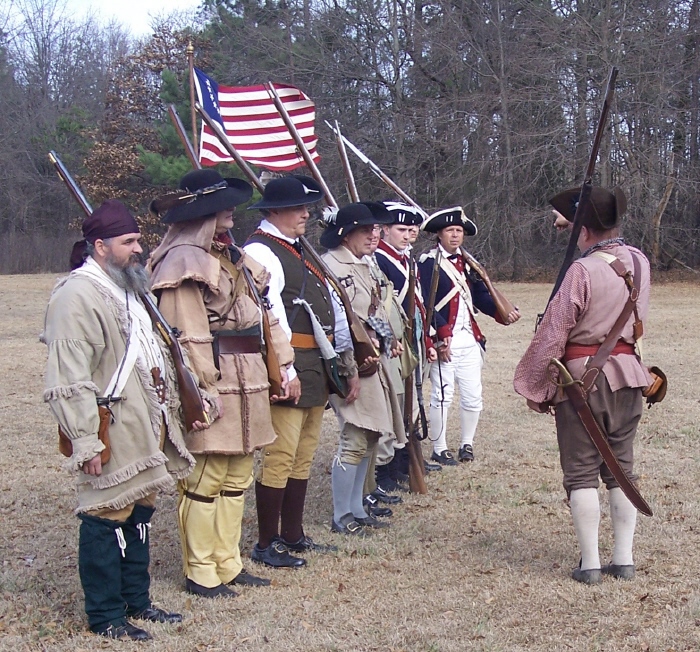The Revolutionary War Battle of Wofford's Iron Works 
The Battle has gone by a variety of names, including Wofford's Iron Works, Cedar Springs No.2, the Peach Orchard, the Old Iron Works, and Buffington. It was largely a running engagement along the road between present-day Camp Croft and Glendale. It started about a mile from Cedar Spring near Wofford's Iron Works, also called the Old Iron Works and, occasionally, Buffington for a previous owner. Part of the action was in a peach orchard, hence the confusion. Regardless of name, it was a bit more extensive and bloody than the first Battle of Cedar Springs.
Following the fall of Charleston on May 12, 1780, the British had moved inland and one of the main leaders in pacifying rebellious elements of the Upcountry was Maj. Patrick Ferguson. Later in the year he would die at King's Mountain. But in August 1780, he was a terror to the Whigs. Ferguson had about 1,800 men. Opposing him was a Patriot force of 1,000 or so that was trying to keep watch on the British major without letting itself become engaged in a major battle until it had grown to more equal size.
To accomplish its mission, 400 men were left to consolidate a base camp and the remainder, a mounted force of some 600 under Cols. Isaac Shelby, Elijah Clarke and William Graham, was sent into nearby Union County to shadow Ferguson and, when possible, cut off his foraging parties.
However, the Whigs found themselves badly outnumbered and fell back to the Spartanburg area, where Aug. 7 found them encamped for the night about two miles west of Cedar Spring. This was near the crossroads where Foster's Tavern (at Highways 56 and 295) would be erected in 1807. Scouts brought word shortly before dawn Aug. 8 that the enemy was within half a mile and the Patriots hastily broke camp and moved via the existing road from Camp Croft to Glendale to a an advantageous position near the old Iron Works. Here, they were attacked by a large detachment of British dragoons and mounted militia riflemen from Ferguson's command under Maj. James Dunlap. The first skirmish lasted about half an hour. Dunlap's mounted riflemen received the initial fire and fell back. After considerable difficulty, Dunlap managed to rally them and, putting himself at the head of the dragoons, initiated a second assault.
The dragoons charged into the Patriot line, where the fighting raged hand-to-hand. But the British riflemen were reluctant to close and before long the badly outnumbered dragoons were thrown back and, together with the riflemen, were pursued for about a mile back along the present road to Camp Croft from Glendale by the victorious Americans before action was broken off and the Patriots returned to their line near the iron works.
Dunlap continued his retreat another mile towards the direction of Camp Croft and met Ferguson with the entire Loyalist force. Ferguson and several hundred of his troops were heading towards the Iron Works. The combined units now moved back towards the Iron Works, where the Americans took one look at the British, decided they were too badly outnumbered to fight, and began a hasty, but organized, withdrawal. The Americans retreated across Lawson's Fork Creek and along much of what is now the Clifton Glendale Road. At the time this route was part of the Old Georgia Road. There was a running battle to the site of present day Clifton. Ferguson was hoping to attack and rescue the British prisoners, but the American leaders took advantage of every favorable position to form their men for battle. This delayed close pursuit until the prisoners could be hurried beyond hope of recapture. Ferguson broke off the battle after the Americans crossed the Pacolet River at what is now Clifton.
Casualty estimates vary widely. Depending on which source you prefer, American losses ran from three killed and 21 wounded to 50 killed, and the British from eight to 34 killed. Based on the type action, probably the lower American figure is more accurate and somewhere between the two extremes for the British. Graves of the dead could be seen at the site of the Iron Works until recent years.
In addition, both sides likely had a number of wounded and Dunlap left quite a few prisoners in American hands, many of them probably also wounded.
Both sides claimed victory and probably the honors should be shared. The Americans certainly won the hand-to-hand contest, probably had fewer casualties and captured more prisoners. The British, on the other hand, held possession of the field and were advancing against a retreating foe when the fighting ended.

This web site has been started as a public service to share the story of Glendale. See more information about Mary and her Glendale connection at Mary McKinney Teaster.